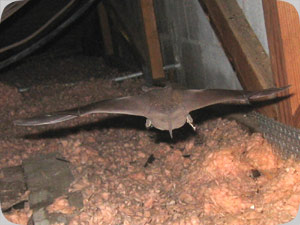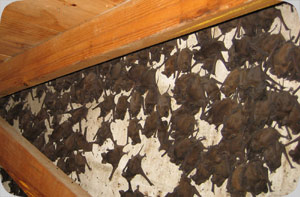
Bats in the Attic
| Bats love to live inside attics. Attics provide an ideal habitat to the colonizing bats of Florida. Attics are like big, warm, hollow trees, but better. Bats can, and prefer to, sneak through very tight gaps, usually about a half of an inch. Many homes have several such gaps - by vents, fascia boards, etc, and the bats fly right in. Once they find an attic that they like, they live there as a group, and they do not leave, ever. If left untreated, a colony will stay for hundreds of years and grow to massive size. Bats like to live in warm areas, sometimes up to 150 degrees, and Florida's attics are just perfect. They roost in the attic by day, and fly out at dusk. While in the attic, they generally don't fly around much, but they do crawl around, and they poop and pee all day, and leave your attic a royal mess! |  |
 | Bats don't cling upside-down to the roof of the attic, and they are rarely seen flying around. Instead, they tend to cluster in groups, usually in tight gaps. Here we see a photo of an attic infested with over 1000 Brazilian Free-Tail Bats. In many cases bats enter an attic through many gaps, but this whole group was able to exit and enter one small hole only one half inch wide by four inches long! They made a huge mess in the attic with their droppings, most of which tumbled down a wall, and stunk up the building. I removed this whole group without harming a single bat, and I cleaned up all of the guano out of the walls. If you need bats removed from your attic in Florida, give us a call, and we will come inspect your attic. |
For an explanation of bat removal from attic prices, click here: bat control prices.
How to Remove Bats from the Attic
Bats are considered to be beneficial and are truly important for their part in our eco-system but when they take up residence in your attic getting them out can be difficult and in some cases dangerous. You will need to know how to remove bats from the attic without harming them as they are the only flying mammal in existence and are protected by national and local wildlife agencies.
Biology and Habitat:
Most of the bats that make their home in your attic come from a few different special groups that look identical to the untrained eye. Bats use something like a radar system when they fly, not because they cannot see but because they can catch insects at incredibly fast speeds. Bats have wings that have hands attached at the ends. They are the most effective insect controller in the world and can be found nearly everywhere. A bat will have up to three deliveries a season depending on the species and these are generally only one pup at a time. Experts believe this is because they must fly to forage while they are pregnant. Bat colonies are usually in an attic because they can stay dry and warm while the mothers nurse their young. Bats are a nocturnal animal because that is when the bugs are the most active and it is their main source of food.
Removing Colonies Yourself:
In colony removal, or when many have made a home out of your attic or out building, you will need to have a plan. Inspect the building and secure all of the tiniest ways an animal can get in. Most likely you will find their main entrance while doing this. While some people may consider trapping these animals-it is absolutely a big no! These are such integral creatures to the ecosystem that it is vital to simply exclude them from becoming a residence. This is an animal that it is important to understand about their natural living patterns because they can be removed safely if you are very attentive to detail. For instance you’ll want to get an inspection of their species to understand their patterns. You’ll inspect the building to see where they’re getting in. You’ll block all areas into the building but one. At night when the bats have left to forage on bugs you can block the remaining entrance, be sure to check there are none trapped before doing so.
Single ‘Trapped’ Bats:
It is not unusual for a family to find a bat loose in their home. This is not a group attempting to live there but a loner caught. Many times a homeowner attempts to capture and remove the bat on their own. This can end badly; the person getting hurt, things getting broken or a bat getting injured. For this instance call a professional for assistance. If you did succeed in removing bats whether in a colony or a trapped animal, you will have the mess that they left behind. The removal of guano from a colony should be done by professionals who have the equipment to handle the job as it can be extremely hazardous to a person’s respiratory functions.
Calling for Professional Wildlife Removal:
For your safety when deciding how to remove bats from the attic call someone that has experience in removing them. The professionals know how to remove the bats and droppings safely. They will not only remove or exclude and clean-up; they will also help make sure that bats do not return.
Why Remove Them If Their So Ecologically Beneficial?
Once you have a colony of bats and they are comfortable, the colony will grow along with the problems of having bats living in your home. Not only can they cause a bad odor, their bat droppings (guano) can carry serious diseases to you and your family. Bats will also bite a human if aggravated, although there are no blood sucking bats in the United States, they do carry rabies. Guano also emits an ammonia smell that is rancid and carries a deadly fungus. If the bat droppings get too thick it can rot your ceiling and leak through causing even more damage to your property and you. Bats are the major carrier of rabies and their droppings, when breathed, can cause histoplasmosis. This deadly fungus disease is found in the guano and will attack the lungs. Though they are extremely beneficial to the ecosystem, they are not an animal you want to cohabitate with.
All of the content and photos (even the background wallpaper) is by me, the owner of the Orlando Bat Removal company. We are based in Orlando and service all of central Florida, and in fact the whole state of Florida, including Tampa and Miami. We operate in the towns of Winter Park, Lake Mary, Longwood, Deltona, Sanford, Conway, Doctor Phillips, Metro West, Kissimmee, and more. If you have any questions about a bat problem in Florida, give us a call, and we can schedule an appointment to inspect the problem and get it taken care of.
